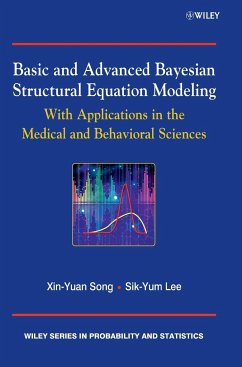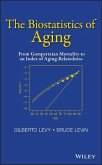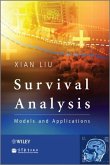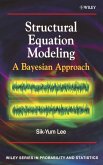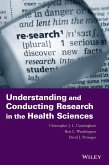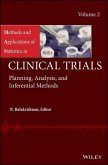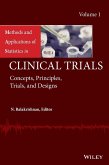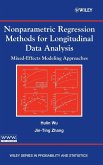- Gebundenes Buch
- Merkliste
- Auf die Merkliste
- Bewerten Bewerten
- Teilen
- Produkt teilen
- Produkterinnerung
- Produkterinnerung
Basic and Advanced Structural Equation Models for Medical and Behavioural Sciences introduces the Bayesian approach to SEMs, including the selection of prior distributions and data augmentation, and offers an overview of the subject's recent advances. This book takes a Bayesian approach to SEMs allowing the use of prior information resulting in improved parameter estimates, latent variable estimates, and statistics for model comparison, as well as offering more reliable results for smaller samples.
This book provides clear instructions to researchers on how to apply Structural Equation…mehr
Andere Kunden interessierten sich auch für
![The Biostatistics of Aging The Biostatistics of Aging]() Gilberto LevyThe Biostatistics of Aging117,99 €
Gilberto LevyThe Biostatistics of Aging117,99 €![Survival Analysis Survival Analysis]() Xian LiuSurvival Analysis115,99 €
Xian LiuSurvival Analysis115,99 €![Structural Equation Modeling Structural Equation Modeling]() Sik-Yum LeeStructural Equation Modeling152,99 €
Sik-Yum LeeStructural Equation Modeling152,99 €![Understanding and Conducting R Understanding and Conducting R]() Christopher J. L. CunninghamUnderstanding and Conducting R139,99 €
Christopher J. L. CunninghamUnderstanding and Conducting R139,99 €![Methods and Applications of Statistics in Clinical Trials, Volume 2 Methods and Applications of Statistics in Clinical Trials, Volume 2]() Methods and Applications of Statistics in Clinical Trials, Volume 2207,99 €
Methods and Applications of Statistics in Clinical Trials, Volume 2207,99 €![MAS Clinical Trials v1 MAS Clinical Trials v1]() MAS Clinical Trials v1213,99 €
MAS Clinical Trials v1213,99 €![Nonparametric Regression Methods for Longitudinal Data Analysis Nonparametric Regression Methods for Longitudinal Data Analysis]() Hulin WuNonparametric Regression Methods for Longitudinal Data Analysis159,99 €
Hulin WuNonparametric Regression Methods for Longitudinal Data Analysis159,99 €-
-
-
Basic and Advanced Structural Equation Models for Medical and Behavioural Sciences introduces the Bayesian approach to SEMs, including the selection of prior distributions and data augmentation, and offers an overview of the subject's recent advances. This book takes a Bayesian approach to SEMs allowing the use of prior information resulting in improved parameter estimates, latent variable estimates, and statistics for model comparison, as well as offering more reliable results for smaller samples.
This book provides clear instructions to researchers on how to apply Structural Equation Models (SEMs) for analyzing the inter relationships between observed and latent variables.
Basic and Advanced Bayesian Structural Equation Modeling introduces basic and advanced SEMs for analyzing various kinds of complex data, such as ordered and unordered categorical data, multilevel data, mixture data, longitudinal data, highly non-normal data, as well as some of their combinations. In addition, Bayesian semiparametric SEMs to capture the true distribution of explanatory latent variables are introduced, whilst SEM with a nonparametric structural equation to assess unspecified functional relationships among latent variables are also explored.
Statistical methodologies are developed using the Bayesian approach giving reliable results for small samples and allowing the use of prior information leading to better statistical results. Estimates of the parameters and model comparison statistics are obtained via powerful Markov Chain Monte Carlo methods in statistical computing.
Introduces the Bayesian approach to SEMs, including discussion on the selection of prior distributions, and data augmentation.
Demonstrates how to utilize the recent powerful tools in statistical computing including, but not limited to, the Gibbs sampler, the Metropolis-Hasting algorithm, and path sampling for producing various statistical results such as Bayesian estimates and Bayesian model comparison statistics in the analysis of basic and advanced SEMs.
Discusses the Bayes factor, Deviance Information Criterion (DIC), and $L_\nu$-measure for Bayesian model comparison.
Introduces a number of important generalizations of SEMs, including multilevel and mixture SEMs, latent curve models and longitudinal SEMs, semiparametric SEMs and those with various types of discrete data, and nonparametric structural equations.
Illustrates how to use the freely available software WinBUGS to produce the results.
Provides numerous real examples for illustrating the theoretical concepts and computational procedures that are presented throughout the book.
Researchers and advanced level students in statistics, biostatistics, public health, business, education, psychology and social science will benefit from this book.
This book provides clear instructions to researchers on how to apply Structural Equation Models (SEMs) for analyzing the inter relationships between observed and latent variables.
Basic and Advanced Bayesian Structural Equation Modeling introduces basic and advanced SEMs for analyzing various kinds of complex data, such as ordered and unordered categorical data, multilevel data, mixture data, longitudinal data, highly non-normal data, as well as some of their combinations. In addition, Bayesian semiparametric SEMs to capture the true distribution of explanatory latent variables are introduced, whilst SEM with a nonparametric structural equation to assess unspecified functional relationships among latent variables are also explored.
Statistical methodologies are developed using the Bayesian approach giving reliable results for small samples and allowing the use of prior information leading to better statistical results. Estimates of the parameters and model comparison statistics are obtained via powerful Markov Chain Monte Carlo methods in statistical computing.
Introduces the Bayesian approach to SEMs, including discussion on the selection of prior distributions, and data augmentation.
Demonstrates how to utilize the recent powerful tools in statistical computing including, but not limited to, the Gibbs sampler, the Metropolis-Hasting algorithm, and path sampling for producing various statistical results such as Bayesian estimates and Bayesian model comparison statistics in the analysis of basic and advanced SEMs.
Discusses the Bayes factor, Deviance Information Criterion (DIC), and $L_\nu$-measure for Bayesian model comparison.
Introduces a number of important generalizations of SEMs, including multilevel and mixture SEMs, latent curve models and longitudinal SEMs, semiparametric SEMs and those with various types of discrete data, and nonparametric structural equations.
Illustrates how to use the freely available software WinBUGS to produce the results.
Provides numerous real examples for illustrating the theoretical concepts and computational procedures that are presented throughout the book.
Researchers and advanced level students in statistics, biostatistics, public health, business, education, psychology and social science will benefit from this book.
Produktdetails
- Produktdetails
- Wiley Series in Probability and Statistics
- Verlag: Wiley & Sons
- 1. Auflage
- Seitenzahl: 400
- Erscheinungstermin: 17. September 2012
- Englisch
- Abmessung: 250mm x 175mm x 26mm
- Gewicht: 842g
- ISBN-13: 9780470669525
- ISBN-10: 0470669527
- Artikelnr.: 35456046
- Herstellerkennzeichnung
- Libri GmbH
- Europaallee 1
- 36244 Bad Hersfeld
- gpsr@libri.de
- Wiley Series in Probability and Statistics
- Verlag: Wiley & Sons
- 1. Auflage
- Seitenzahl: 400
- Erscheinungstermin: 17. September 2012
- Englisch
- Abmessung: 250mm x 175mm x 26mm
- Gewicht: 842g
- ISBN-13: 9780470669525
- ISBN-10: 0470669527
- Artikelnr.: 35456046
- Herstellerkennzeichnung
- Libri GmbH
- Europaallee 1
- 36244 Bad Hersfeld
- gpsr@libri.de
Xin-Yuan Song and Sik-Yum Lee, Department of Statistics, The Chinese University of Hong Kong
About the authors xiii Preface xv 1 Introduction 1 1.1 Observed and latent variables 1 1.2 Structural equation model 3 1.3 Objectives of the book 3 1.4 The Bayesian approach 4 1.5 Real data sets and notation 5 Appendix 1.1: Information on real data sets 7 References 14 2 Basic concepts and applications of structural equation models 16 2.1 Introduction 16 2.2 Linear SEMs 17 2.2.1 Measurement equation 18 2.2.2 Structural equation and one extension 19 2.2.3 Assumptions of linear SEMs 20 2.2.4 Model identification 21 2.2.5 Path diagram 22 2.3 SEMs with fixed covariates 23 2.3.1 The model 23 2.3.2 An artificial example 24 2.4 Nonlinear SEMs 25 2.4.1 Basic nonlinear SEMs 25 2.4.2 Nonlinear SEMs with fixed covariates 27 2.4.3 Remarks 29 2.5 Discussion and conclusions 29 References 33 3 Bayesian methods for estimating structural equation models 34 3.1 Introduction 34 3.2 Basic concepts of the Bayesian estimation and prior distributions 35 3.2.1 Prior distributions 36 3.2.2 Conjugate prior distributions in Bayesian analyses of SEMs 37 3.3 Posterior analysis using Markov chain Monte Carlo methods 40 3.4 Application of Markov chain Monte Carlo methods 43 3.5 Bayesian estimation via WinBUGS 45 Appendix 3.1: The gamma, inverted gamma, Wishart, and inverted Wishart distributions and their characteristics 53 Appendix 3.2: The Metropolis-Hastings algorithm 54 Appendix 3.3: Conditional distributions [ Y,
] and [
Y,] 55 Appendix 3.4: Conditional distributions [ Y,
] and [
Y,] in nonlinear SEMs with covariates 58 Appendix 3.5: WinBUGS code 60 Appendix 3.6: R2WinBUGS code 61 References 62 4 Bayesian model comparison and model checking 64 4.1 Introduction 64 4.2 Bayes factor 65 4.2.1 Path sampling 67 4.2.2 A simulation study 70 4.3 Other model comparison statistics 73 4.3.1 Bayesian information criterion and Akaike information criterion 73 4.3.2 Deviance information criterion 74 4.3.3 L
-measure 75 4.4 Illustration 76 4.5 Goodness of fit and model checking methods 78 4.5.1 Posterior predictive p-value 78 4.5.2 Residual analysis 78 Appendix 4.1: WinBUGS code 80 Appendix 4.2: R code in Bayes factor example 81 Appendix 4.3: Posterior predictive p-value for model assessment 83 References 83 5 Practical structural equation models 86 5.1 Introduction 86 5.2 SEMs with continuous and ordered categorical variables 86 5.2.1 Introduction 86 5.2.2 The basic model 88 5.2.3 Bayesian analysis 90 5.2.4 Application: Bayesian analysis of quality of life data 90 5.2.5 SEMs with dichotomous variables 94 5.3 SEMs with variables from exponential family distributions 95 5.3.1 Introduction 95 5.3.2 The SEM framework with exponential family distributions 96 5.3.3 Bayesian inference 97 5.3.4 Simulation study 98 5.4 SEMs with missing data 102 5.4.1 Introduction 102 5.4.2 SEMs with missing data that are MAR 103 5.4.3 An illustrative example 105 5.4.4 Nonlinear SEMs with nonignorable missing data 108 5.4.5 An illustrative real example 111 Appendix 5.1: Conditional distributions and implementation of the MH algorithm for SEMs with continuous and ordered categorical variables 115 Appendix 5.2: Conditional distributions and implementation of MH algorithm for SEMs with EFDs 119 Appendix 5.3: WinBUGS code related to section 5.3.4 122 Appendix 5.4: R2WinBUGS code related to section 5.3.4 123 Appendix 5.5: Conditional distributions for SEMs with nonignorable missing data 126 References 127 6 Structural equation models with hierarchical and multisample data 130 6.1 Introduction 130 6.2 Two-level structural equation models 131 6.2.1 Two-level nonlinear SEM with mixed type variables 131 6.2.2 Bayesian inference 133 6.2.3 Application: Filipina CSWs study 136 6.3 Structural equation models with multisample data 141 6.3.1 Bayesian analysis of a nonlinear SEM in different groups 143 6.3.2 Analysis of multisample quality of life data via WinBUGS 147 Appendix 6.1: Conditional distributions: Two-level nonlinear SEM 150 Appendix 6.2: The MH algorithm: Two-level nonlinear SEM 153 Appendix 6.3: PP p-value for two-level nonlinear SEM with mixed continuous and ordered categorical variables 155 Appendix 6.4: WinBUGS code 156 Appendix 6.5: Conditional distributions: Multisample SEMs 158 References 160 7 Mixture structural equation models 162 7.1 Introduction 162 7.2 Finite mixture SEMs 163 7.2.1 The model 163 7.2.2 Bayesian estimation 164 7.2.3 Analysis of an artificial example 168 7.2.4 Example from the world values survey 170 7.2.5 Bayesian model comparison of mixture SEMs 173 7.2.6 An illustrative example 176 7.3 A Modified mixture SEM 178 7.3.1 Model description 178 7.3.2 Bayesian estimation 180 7.3.3 Bayesian model selection using a modified DIC 182 7.3.4 An illustrative example 183 Appendix 7.1: The permutation sampler 189 Appendix 7.2: Searching for identifiability constraints 190 Appendix 7.3: Conditional distributions: Modified mixture SEMs 191 References 194 8 Structural equation modeling for latent curve models 196 8.1 Introduction 196 8.2 Background to the real studies 197 8.2.1 A longitudinal study of quality of life of stroke survivors 197 8.2.2 A longitudinal study of cocaine use 198 8.3 Latent curve models 199 8.3.1 Basic latent curve models 199 8.3.2 Latent curve models with explanatory latent variables 200 8.3.3 Latent curve models with longitudinal latent variables 201 8.4 Bayesian analysis 205 8.5 Applications to two longitudinal studies 206 8.5.1 Longitudinal study of cocaine use 206 8.5.2 Health-related quality of life for stroke survivors 210 8.6 Other latent curve models 213 8.6.1 Nonlinear latent curve models 214 8.6.2 Multilevel latent curve models 215 8.6.3 Mixture latent curve models 215 Appendix 8.1: Conditional distributions 218 Appendix 8.2: WinBUGS code for the analysis of cocaine use data 220 References 222 9 Longitudinal structural equation models 224 9.1 Introduction 224 9.2 A two-level SEM for analyzing multivariate longitudinal data 226 9.3 Bayesian analysis of the two-level longitudinal SEM 228 9.3.1 Bayesian estimation 228 9.3.2 Model comparison via the L
-measure 230 9.4 Simulation study 231 9.5 Application: Longitudinal study of cocaine use 232 9.6 Discussion 236 Appendix 9.1: Full conditional distributions for implementing the Gibbs sampler 241 Appendix 9.2: Approximation of the L
-measure in equation (9.9) via MCMC samples 244 References 245 10 Semiparametric structural equation models with continuous variables 247 10.1 Introduction 247 10.2 Bayesian semiparametric hierarchical modeling of SEMs with covariates 249 10.3 Bayesian estimation and model comparison 251 10.4 Application: Kidney disease study 252 10.5 Simulation studies 259 10.5.1 Simulation study of estimation 259 10.5.2 Simulation study of model comparison 262 10.5.3 Obtaining the L
-measure via WinBUGS and R2WinBUGS 264 10.6 Discussion 265 Appendix 10.1: Conditional distributions for parametric components 267 Appendix 10.2: Conditional distributions for nonparametric components 268 References 269 11 Structural equation models with mixed continuous and unordered categorical variables 271 11.1 Introduction 271 11.2 Parametric SEMs with continuous and unordered categorical variables 272 11.2.1 The model 272 11.2.2 Application to diabetic kidney disease 274 11.2.3 Bayesian estimation and model comparison 276 11.2.4 Application to the diabetic kidney disease data 277 11.3 Bayesian semiparametric SEM with continuous and unordered categorical variables 280 11.3.1 Formulation of the semiparametric SEM 282 11.3.2 Semiparametric hierarchical modeling via the Dirichlet process 283 11.3.3 Estimation and model comparison 285 11.3.4 Simulation study 286 11.3.5 Real example: Diabetic nephropathy study 289 Appendix 11.1: Full conditional distributions 295 Appendix 11.2: Path sampling 298 Appendix 11.3: A modified truncated DP related to equation (11.19) 299 Appendix 11.4: Conditional distributions and the MH algorithm for the Bayesian semiparametric model 300 References 304 12 Structural equation models with nonparametric structural equations 306 12.1 Introduction 306 12.2 Nonparametric SEMs with Bayesian P-splines 307 12.2.1 Model description 307 12.2.2 General formulation of the Bayesian P-splines 308 12.2.3 Modeling nonparametric functions of latent variables 309 12.2.4 Prior distributions 310 12.2.5 Posterior inference via Markov chain Monte Carlo sampling 312 12.2.6 Simulation study 313 12.2.7 A study on osteoporosis prevention and control 316 12.3 Generalized nonparametric structural equation models 320 12.3.1 Model description 320 12.3.2 Bayesian P-splines 322 12.3.3 Prior distributions 324 12.3.4 Bayesian estimation and model comparison 325 12.3.5 National longitudinal surveys of youth study 327 12.4 Discussion 331 Appendix 12.1: Conditional distributions and the MH algorithm: Nonparametric SEMs 333 Appendix 12.2: Conditional distributions in generalized nonparametric SEMs 336 References 338 13 Transformation structural equation models 341 13.1 Introduction 341 13.2 Model description 342 13.3 Modeling nonparametric transformations 343 13.4 Identifiability constraints and prior distributions 344 13.5 Posterior inference with MCMC algorithms 345 13.5.1 Conditional distributions 345 13.5.2 The random-ray algorithm 346 13.5.3 Modifications of the random-ray algorithm 347 13.6 Simulation study 348 13.7 A study on the intervention treatment of polydrug use 350 13.8 Discussion 354 References 355 14 Conclusion 358 References 360 Index 361
] and [
Y,] 55 Appendix 3.4: Conditional distributions [ Y,
] and [
Y,] in nonlinear SEMs with covariates 58 Appendix 3.5: WinBUGS code 60 Appendix 3.6: R2WinBUGS code 61 References 62 4 Bayesian model comparison and model checking 64 4.1 Introduction 64 4.2 Bayes factor 65 4.2.1 Path sampling 67 4.2.2 A simulation study 70 4.3 Other model comparison statistics 73 4.3.1 Bayesian information criterion and Akaike information criterion 73 4.3.2 Deviance information criterion 74 4.3.3 L
-measure 75 4.4 Illustration 76 4.5 Goodness of fit and model checking methods 78 4.5.1 Posterior predictive p-value 78 4.5.2 Residual analysis 78 Appendix 4.1: WinBUGS code 80 Appendix 4.2: R code in Bayes factor example 81 Appendix 4.3: Posterior predictive p-value for model assessment 83 References 83 5 Practical structural equation models 86 5.1 Introduction 86 5.2 SEMs with continuous and ordered categorical variables 86 5.2.1 Introduction 86 5.2.2 The basic model 88 5.2.3 Bayesian analysis 90 5.2.4 Application: Bayesian analysis of quality of life data 90 5.2.5 SEMs with dichotomous variables 94 5.3 SEMs with variables from exponential family distributions 95 5.3.1 Introduction 95 5.3.2 The SEM framework with exponential family distributions 96 5.3.3 Bayesian inference 97 5.3.4 Simulation study 98 5.4 SEMs with missing data 102 5.4.1 Introduction 102 5.4.2 SEMs with missing data that are MAR 103 5.4.3 An illustrative example 105 5.4.4 Nonlinear SEMs with nonignorable missing data 108 5.4.5 An illustrative real example 111 Appendix 5.1: Conditional distributions and implementation of the MH algorithm for SEMs with continuous and ordered categorical variables 115 Appendix 5.2: Conditional distributions and implementation of MH algorithm for SEMs with EFDs 119 Appendix 5.3: WinBUGS code related to section 5.3.4 122 Appendix 5.4: R2WinBUGS code related to section 5.3.4 123 Appendix 5.5: Conditional distributions for SEMs with nonignorable missing data 126 References 127 6 Structural equation models with hierarchical and multisample data 130 6.1 Introduction 130 6.2 Two-level structural equation models 131 6.2.1 Two-level nonlinear SEM with mixed type variables 131 6.2.2 Bayesian inference 133 6.2.3 Application: Filipina CSWs study 136 6.3 Structural equation models with multisample data 141 6.3.1 Bayesian analysis of a nonlinear SEM in different groups 143 6.3.2 Analysis of multisample quality of life data via WinBUGS 147 Appendix 6.1: Conditional distributions: Two-level nonlinear SEM 150 Appendix 6.2: The MH algorithm: Two-level nonlinear SEM 153 Appendix 6.3: PP p-value for two-level nonlinear SEM with mixed continuous and ordered categorical variables 155 Appendix 6.4: WinBUGS code 156 Appendix 6.5: Conditional distributions: Multisample SEMs 158 References 160 7 Mixture structural equation models 162 7.1 Introduction 162 7.2 Finite mixture SEMs 163 7.2.1 The model 163 7.2.2 Bayesian estimation 164 7.2.3 Analysis of an artificial example 168 7.2.4 Example from the world values survey 170 7.2.5 Bayesian model comparison of mixture SEMs 173 7.2.6 An illustrative example 176 7.3 A Modified mixture SEM 178 7.3.1 Model description 178 7.3.2 Bayesian estimation 180 7.3.3 Bayesian model selection using a modified DIC 182 7.3.4 An illustrative example 183 Appendix 7.1: The permutation sampler 189 Appendix 7.2: Searching for identifiability constraints 190 Appendix 7.3: Conditional distributions: Modified mixture SEMs 191 References 194 8 Structural equation modeling for latent curve models 196 8.1 Introduction 196 8.2 Background to the real studies 197 8.2.1 A longitudinal study of quality of life of stroke survivors 197 8.2.2 A longitudinal study of cocaine use 198 8.3 Latent curve models 199 8.3.1 Basic latent curve models 199 8.3.2 Latent curve models with explanatory latent variables 200 8.3.3 Latent curve models with longitudinal latent variables 201 8.4 Bayesian analysis 205 8.5 Applications to two longitudinal studies 206 8.5.1 Longitudinal study of cocaine use 206 8.5.2 Health-related quality of life for stroke survivors 210 8.6 Other latent curve models 213 8.6.1 Nonlinear latent curve models 214 8.6.2 Multilevel latent curve models 215 8.6.3 Mixture latent curve models 215 Appendix 8.1: Conditional distributions 218 Appendix 8.2: WinBUGS code for the analysis of cocaine use data 220 References 222 9 Longitudinal structural equation models 224 9.1 Introduction 224 9.2 A two-level SEM for analyzing multivariate longitudinal data 226 9.3 Bayesian analysis of the two-level longitudinal SEM 228 9.3.1 Bayesian estimation 228 9.3.2 Model comparison via the L
-measure 230 9.4 Simulation study 231 9.5 Application: Longitudinal study of cocaine use 232 9.6 Discussion 236 Appendix 9.1: Full conditional distributions for implementing the Gibbs sampler 241 Appendix 9.2: Approximation of the L
-measure in equation (9.9) via MCMC samples 244 References 245 10 Semiparametric structural equation models with continuous variables 247 10.1 Introduction 247 10.2 Bayesian semiparametric hierarchical modeling of SEMs with covariates 249 10.3 Bayesian estimation and model comparison 251 10.4 Application: Kidney disease study 252 10.5 Simulation studies 259 10.5.1 Simulation study of estimation 259 10.5.2 Simulation study of model comparison 262 10.5.3 Obtaining the L
-measure via WinBUGS and R2WinBUGS 264 10.6 Discussion 265 Appendix 10.1: Conditional distributions for parametric components 267 Appendix 10.2: Conditional distributions for nonparametric components 268 References 269 11 Structural equation models with mixed continuous and unordered categorical variables 271 11.1 Introduction 271 11.2 Parametric SEMs with continuous and unordered categorical variables 272 11.2.1 The model 272 11.2.2 Application to diabetic kidney disease 274 11.2.3 Bayesian estimation and model comparison 276 11.2.4 Application to the diabetic kidney disease data 277 11.3 Bayesian semiparametric SEM with continuous and unordered categorical variables 280 11.3.1 Formulation of the semiparametric SEM 282 11.3.2 Semiparametric hierarchical modeling via the Dirichlet process 283 11.3.3 Estimation and model comparison 285 11.3.4 Simulation study 286 11.3.5 Real example: Diabetic nephropathy study 289 Appendix 11.1: Full conditional distributions 295 Appendix 11.2: Path sampling 298 Appendix 11.3: A modified truncated DP related to equation (11.19) 299 Appendix 11.4: Conditional distributions and the MH algorithm for the Bayesian semiparametric model 300 References 304 12 Structural equation models with nonparametric structural equations 306 12.1 Introduction 306 12.2 Nonparametric SEMs with Bayesian P-splines 307 12.2.1 Model description 307 12.2.2 General formulation of the Bayesian P-splines 308 12.2.3 Modeling nonparametric functions of latent variables 309 12.2.4 Prior distributions 310 12.2.5 Posterior inference via Markov chain Monte Carlo sampling 312 12.2.6 Simulation study 313 12.2.7 A study on osteoporosis prevention and control 316 12.3 Generalized nonparametric structural equation models 320 12.3.1 Model description 320 12.3.2 Bayesian P-splines 322 12.3.3 Prior distributions 324 12.3.4 Bayesian estimation and model comparison 325 12.3.5 National longitudinal surveys of youth study 327 12.4 Discussion 331 Appendix 12.1: Conditional distributions and the MH algorithm: Nonparametric SEMs 333 Appendix 12.2: Conditional distributions in generalized nonparametric SEMs 336 References 338 13 Transformation structural equation models 341 13.1 Introduction 341 13.2 Model description 342 13.3 Modeling nonparametric transformations 343 13.4 Identifiability constraints and prior distributions 344 13.5 Posterior inference with MCMC algorithms 345 13.5.1 Conditional distributions 345 13.5.2 The random-ray algorithm 346 13.5.3 Modifications of the random-ray algorithm 347 13.6 Simulation study 348 13.7 A study on the intervention treatment of polydrug use 350 13.8 Discussion 354 References 355 14 Conclusion 358 References 360 Index 361
About the authors xiii Preface xv 1 Introduction 1 1.1 Observed and latent variables 1 1.2 Structural equation model 3 1.3 Objectives of the book 3 1.4 The Bayesian approach 4 1.5 Real data sets and notation 5 Appendix 1.1: Information on real data sets 7 References 14 2 Basic concepts and applications of structural equation models 16 2.1 Introduction 16 2.2 Linear SEMs 17 2.2.1 Measurement equation 18 2.2.2 Structural equation and one extension 19 2.2.3 Assumptions of linear SEMs 20 2.2.4 Model identification 21 2.2.5 Path diagram 22 2.3 SEMs with fixed covariates 23 2.3.1 The model 23 2.3.2 An artificial example 24 2.4 Nonlinear SEMs 25 2.4.1 Basic nonlinear SEMs 25 2.4.2 Nonlinear SEMs with fixed covariates 27 2.4.3 Remarks 29 2.5 Discussion and conclusions 29 References 33 3 Bayesian methods for estimating structural equation models 34 3.1 Introduction 34 3.2 Basic concepts of the Bayesian estimation and prior distributions 35 3.2.1 Prior distributions 36 3.2.2 Conjugate prior distributions in Bayesian analyses of SEMs 37 3.3 Posterior analysis using Markov chain Monte Carlo methods 40 3.4 Application of Markov chain Monte Carlo methods 43 3.5 Bayesian estimation via WinBUGS 45 Appendix 3.1: The gamma, inverted gamma, Wishart, and inverted Wishart distributions and their characteristics 53 Appendix 3.2: The Metropolis-Hastings algorithm 54 Appendix 3.3: Conditional distributions [ Y,
] and [
Y,] 55 Appendix 3.4: Conditional distributions [ Y,
] and [
Y,] in nonlinear SEMs with covariates 58 Appendix 3.5: WinBUGS code 60 Appendix 3.6: R2WinBUGS code 61 References 62 4 Bayesian model comparison and model checking 64 4.1 Introduction 64 4.2 Bayes factor 65 4.2.1 Path sampling 67 4.2.2 A simulation study 70 4.3 Other model comparison statistics 73 4.3.1 Bayesian information criterion and Akaike information criterion 73 4.3.2 Deviance information criterion 74 4.3.3 L
-measure 75 4.4 Illustration 76 4.5 Goodness of fit and model checking methods 78 4.5.1 Posterior predictive p-value 78 4.5.2 Residual analysis 78 Appendix 4.1: WinBUGS code 80 Appendix 4.2: R code in Bayes factor example 81 Appendix 4.3: Posterior predictive p-value for model assessment 83 References 83 5 Practical structural equation models 86 5.1 Introduction 86 5.2 SEMs with continuous and ordered categorical variables 86 5.2.1 Introduction 86 5.2.2 The basic model 88 5.2.3 Bayesian analysis 90 5.2.4 Application: Bayesian analysis of quality of life data 90 5.2.5 SEMs with dichotomous variables 94 5.3 SEMs with variables from exponential family distributions 95 5.3.1 Introduction 95 5.3.2 The SEM framework with exponential family distributions 96 5.3.3 Bayesian inference 97 5.3.4 Simulation study 98 5.4 SEMs with missing data 102 5.4.1 Introduction 102 5.4.2 SEMs with missing data that are MAR 103 5.4.3 An illustrative example 105 5.4.4 Nonlinear SEMs with nonignorable missing data 108 5.4.5 An illustrative real example 111 Appendix 5.1: Conditional distributions and implementation of the MH algorithm for SEMs with continuous and ordered categorical variables 115 Appendix 5.2: Conditional distributions and implementation of MH algorithm for SEMs with EFDs 119 Appendix 5.3: WinBUGS code related to section 5.3.4 122 Appendix 5.4: R2WinBUGS code related to section 5.3.4 123 Appendix 5.5: Conditional distributions for SEMs with nonignorable missing data 126 References 127 6 Structural equation models with hierarchical and multisample data 130 6.1 Introduction 130 6.2 Two-level structural equation models 131 6.2.1 Two-level nonlinear SEM with mixed type variables 131 6.2.2 Bayesian inference 133 6.2.3 Application: Filipina CSWs study 136 6.3 Structural equation models with multisample data 141 6.3.1 Bayesian analysis of a nonlinear SEM in different groups 143 6.3.2 Analysis of multisample quality of life data via WinBUGS 147 Appendix 6.1: Conditional distributions: Two-level nonlinear SEM 150 Appendix 6.2: The MH algorithm: Two-level nonlinear SEM 153 Appendix 6.3: PP p-value for two-level nonlinear SEM with mixed continuous and ordered categorical variables 155 Appendix 6.4: WinBUGS code 156 Appendix 6.5: Conditional distributions: Multisample SEMs 158 References 160 7 Mixture structural equation models 162 7.1 Introduction 162 7.2 Finite mixture SEMs 163 7.2.1 The model 163 7.2.2 Bayesian estimation 164 7.2.3 Analysis of an artificial example 168 7.2.4 Example from the world values survey 170 7.2.5 Bayesian model comparison of mixture SEMs 173 7.2.6 An illustrative example 176 7.3 A Modified mixture SEM 178 7.3.1 Model description 178 7.3.2 Bayesian estimation 180 7.3.3 Bayesian model selection using a modified DIC 182 7.3.4 An illustrative example 183 Appendix 7.1: The permutation sampler 189 Appendix 7.2: Searching for identifiability constraints 190 Appendix 7.3: Conditional distributions: Modified mixture SEMs 191 References 194 8 Structural equation modeling for latent curve models 196 8.1 Introduction 196 8.2 Background to the real studies 197 8.2.1 A longitudinal study of quality of life of stroke survivors 197 8.2.2 A longitudinal study of cocaine use 198 8.3 Latent curve models 199 8.3.1 Basic latent curve models 199 8.3.2 Latent curve models with explanatory latent variables 200 8.3.3 Latent curve models with longitudinal latent variables 201 8.4 Bayesian analysis 205 8.5 Applications to two longitudinal studies 206 8.5.1 Longitudinal study of cocaine use 206 8.5.2 Health-related quality of life for stroke survivors 210 8.6 Other latent curve models 213 8.6.1 Nonlinear latent curve models 214 8.6.2 Multilevel latent curve models 215 8.6.3 Mixture latent curve models 215 Appendix 8.1: Conditional distributions 218 Appendix 8.2: WinBUGS code for the analysis of cocaine use data 220 References 222 9 Longitudinal structural equation models 224 9.1 Introduction 224 9.2 A two-level SEM for analyzing multivariate longitudinal data 226 9.3 Bayesian analysis of the two-level longitudinal SEM 228 9.3.1 Bayesian estimation 228 9.3.2 Model comparison via the L
-measure 230 9.4 Simulation study 231 9.5 Application: Longitudinal study of cocaine use 232 9.6 Discussion 236 Appendix 9.1: Full conditional distributions for implementing the Gibbs sampler 241 Appendix 9.2: Approximation of the L
-measure in equation (9.9) via MCMC samples 244 References 245 10 Semiparametric structural equation models with continuous variables 247 10.1 Introduction 247 10.2 Bayesian semiparametric hierarchical modeling of SEMs with covariates 249 10.3 Bayesian estimation and model comparison 251 10.4 Application: Kidney disease study 252 10.5 Simulation studies 259 10.5.1 Simulation study of estimation 259 10.5.2 Simulation study of model comparison 262 10.5.3 Obtaining the L
-measure via WinBUGS and R2WinBUGS 264 10.6 Discussion 265 Appendix 10.1: Conditional distributions for parametric components 267 Appendix 10.2: Conditional distributions for nonparametric components 268 References 269 11 Structural equation models with mixed continuous and unordered categorical variables 271 11.1 Introduction 271 11.2 Parametric SEMs with continuous and unordered categorical variables 272 11.2.1 The model 272 11.2.2 Application to diabetic kidney disease 274 11.2.3 Bayesian estimation and model comparison 276 11.2.4 Application to the diabetic kidney disease data 277 11.3 Bayesian semiparametric SEM with continuous and unordered categorical variables 280 11.3.1 Formulation of the semiparametric SEM 282 11.3.2 Semiparametric hierarchical modeling via the Dirichlet process 283 11.3.3 Estimation and model comparison 285 11.3.4 Simulation study 286 11.3.5 Real example: Diabetic nephropathy study 289 Appendix 11.1: Full conditional distributions 295 Appendix 11.2: Path sampling 298 Appendix 11.3: A modified truncated DP related to equation (11.19) 299 Appendix 11.4: Conditional distributions and the MH algorithm for the Bayesian semiparametric model 300 References 304 12 Structural equation models with nonparametric structural equations 306 12.1 Introduction 306 12.2 Nonparametric SEMs with Bayesian P-splines 307 12.2.1 Model description 307 12.2.2 General formulation of the Bayesian P-splines 308 12.2.3 Modeling nonparametric functions of latent variables 309 12.2.4 Prior distributions 310 12.2.5 Posterior inference via Markov chain Monte Carlo sampling 312 12.2.6 Simulation study 313 12.2.7 A study on osteoporosis prevention and control 316 12.3 Generalized nonparametric structural equation models 320 12.3.1 Model description 320 12.3.2 Bayesian P-splines 322 12.3.3 Prior distributions 324 12.3.4 Bayesian estimation and model comparison 325 12.3.5 National longitudinal surveys of youth study 327 12.4 Discussion 331 Appendix 12.1: Conditional distributions and the MH algorithm: Nonparametric SEMs 333 Appendix 12.2: Conditional distributions in generalized nonparametric SEMs 336 References 338 13 Transformation structural equation models 341 13.1 Introduction 341 13.2 Model description 342 13.3 Modeling nonparametric transformations 343 13.4 Identifiability constraints and prior distributions 344 13.5 Posterior inference with MCMC algorithms 345 13.5.1 Conditional distributions 345 13.5.2 The random-ray algorithm 346 13.5.3 Modifications of the random-ray algorithm 347 13.6 Simulation study 348 13.7 A study on the intervention treatment of polydrug use 350 13.8 Discussion 354 References 355 14 Conclusion 358 References 360 Index 361
] and [
Y,] 55 Appendix 3.4: Conditional distributions [ Y,
] and [
Y,] in nonlinear SEMs with covariates 58 Appendix 3.5: WinBUGS code 60 Appendix 3.6: R2WinBUGS code 61 References 62 4 Bayesian model comparison and model checking 64 4.1 Introduction 64 4.2 Bayes factor 65 4.2.1 Path sampling 67 4.2.2 A simulation study 70 4.3 Other model comparison statistics 73 4.3.1 Bayesian information criterion and Akaike information criterion 73 4.3.2 Deviance information criterion 74 4.3.3 L
-measure 75 4.4 Illustration 76 4.5 Goodness of fit and model checking methods 78 4.5.1 Posterior predictive p-value 78 4.5.2 Residual analysis 78 Appendix 4.1: WinBUGS code 80 Appendix 4.2: R code in Bayes factor example 81 Appendix 4.3: Posterior predictive p-value for model assessment 83 References 83 5 Practical structural equation models 86 5.1 Introduction 86 5.2 SEMs with continuous and ordered categorical variables 86 5.2.1 Introduction 86 5.2.2 The basic model 88 5.2.3 Bayesian analysis 90 5.2.4 Application: Bayesian analysis of quality of life data 90 5.2.5 SEMs with dichotomous variables 94 5.3 SEMs with variables from exponential family distributions 95 5.3.1 Introduction 95 5.3.2 The SEM framework with exponential family distributions 96 5.3.3 Bayesian inference 97 5.3.4 Simulation study 98 5.4 SEMs with missing data 102 5.4.1 Introduction 102 5.4.2 SEMs with missing data that are MAR 103 5.4.3 An illustrative example 105 5.4.4 Nonlinear SEMs with nonignorable missing data 108 5.4.5 An illustrative real example 111 Appendix 5.1: Conditional distributions and implementation of the MH algorithm for SEMs with continuous and ordered categorical variables 115 Appendix 5.2: Conditional distributions and implementation of MH algorithm for SEMs with EFDs 119 Appendix 5.3: WinBUGS code related to section 5.3.4 122 Appendix 5.4: R2WinBUGS code related to section 5.3.4 123 Appendix 5.5: Conditional distributions for SEMs with nonignorable missing data 126 References 127 6 Structural equation models with hierarchical and multisample data 130 6.1 Introduction 130 6.2 Two-level structural equation models 131 6.2.1 Two-level nonlinear SEM with mixed type variables 131 6.2.2 Bayesian inference 133 6.2.3 Application: Filipina CSWs study 136 6.3 Structural equation models with multisample data 141 6.3.1 Bayesian analysis of a nonlinear SEM in different groups 143 6.3.2 Analysis of multisample quality of life data via WinBUGS 147 Appendix 6.1: Conditional distributions: Two-level nonlinear SEM 150 Appendix 6.2: The MH algorithm: Two-level nonlinear SEM 153 Appendix 6.3: PP p-value for two-level nonlinear SEM with mixed continuous and ordered categorical variables 155 Appendix 6.4: WinBUGS code 156 Appendix 6.5: Conditional distributions: Multisample SEMs 158 References 160 7 Mixture structural equation models 162 7.1 Introduction 162 7.2 Finite mixture SEMs 163 7.2.1 The model 163 7.2.2 Bayesian estimation 164 7.2.3 Analysis of an artificial example 168 7.2.4 Example from the world values survey 170 7.2.5 Bayesian model comparison of mixture SEMs 173 7.2.6 An illustrative example 176 7.3 A Modified mixture SEM 178 7.3.1 Model description 178 7.3.2 Bayesian estimation 180 7.3.3 Bayesian model selection using a modified DIC 182 7.3.4 An illustrative example 183 Appendix 7.1: The permutation sampler 189 Appendix 7.2: Searching for identifiability constraints 190 Appendix 7.3: Conditional distributions: Modified mixture SEMs 191 References 194 8 Structural equation modeling for latent curve models 196 8.1 Introduction 196 8.2 Background to the real studies 197 8.2.1 A longitudinal study of quality of life of stroke survivors 197 8.2.2 A longitudinal study of cocaine use 198 8.3 Latent curve models 199 8.3.1 Basic latent curve models 199 8.3.2 Latent curve models with explanatory latent variables 200 8.3.3 Latent curve models with longitudinal latent variables 201 8.4 Bayesian analysis 205 8.5 Applications to two longitudinal studies 206 8.5.1 Longitudinal study of cocaine use 206 8.5.2 Health-related quality of life for stroke survivors 210 8.6 Other latent curve models 213 8.6.1 Nonlinear latent curve models 214 8.6.2 Multilevel latent curve models 215 8.6.3 Mixture latent curve models 215 Appendix 8.1: Conditional distributions 218 Appendix 8.2: WinBUGS code for the analysis of cocaine use data 220 References 222 9 Longitudinal structural equation models 224 9.1 Introduction 224 9.2 A two-level SEM for analyzing multivariate longitudinal data 226 9.3 Bayesian analysis of the two-level longitudinal SEM 228 9.3.1 Bayesian estimation 228 9.3.2 Model comparison via the L
-measure 230 9.4 Simulation study 231 9.5 Application: Longitudinal study of cocaine use 232 9.6 Discussion 236 Appendix 9.1: Full conditional distributions for implementing the Gibbs sampler 241 Appendix 9.2: Approximation of the L
-measure in equation (9.9) via MCMC samples 244 References 245 10 Semiparametric structural equation models with continuous variables 247 10.1 Introduction 247 10.2 Bayesian semiparametric hierarchical modeling of SEMs with covariates 249 10.3 Bayesian estimation and model comparison 251 10.4 Application: Kidney disease study 252 10.5 Simulation studies 259 10.5.1 Simulation study of estimation 259 10.5.2 Simulation study of model comparison 262 10.5.3 Obtaining the L
-measure via WinBUGS and R2WinBUGS 264 10.6 Discussion 265 Appendix 10.1: Conditional distributions for parametric components 267 Appendix 10.2: Conditional distributions for nonparametric components 268 References 269 11 Structural equation models with mixed continuous and unordered categorical variables 271 11.1 Introduction 271 11.2 Parametric SEMs with continuous and unordered categorical variables 272 11.2.1 The model 272 11.2.2 Application to diabetic kidney disease 274 11.2.3 Bayesian estimation and model comparison 276 11.2.4 Application to the diabetic kidney disease data 277 11.3 Bayesian semiparametric SEM with continuous and unordered categorical variables 280 11.3.1 Formulation of the semiparametric SEM 282 11.3.2 Semiparametric hierarchical modeling via the Dirichlet process 283 11.3.3 Estimation and model comparison 285 11.3.4 Simulation study 286 11.3.5 Real example: Diabetic nephropathy study 289 Appendix 11.1: Full conditional distributions 295 Appendix 11.2: Path sampling 298 Appendix 11.3: A modified truncated DP related to equation (11.19) 299 Appendix 11.4: Conditional distributions and the MH algorithm for the Bayesian semiparametric model 300 References 304 12 Structural equation models with nonparametric structural equations 306 12.1 Introduction 306 12.2 Nonparametric SEMs with Bayesian P-splines 307 12.2.1 Model description 307 12.2.2 General formulation of the Bayesian P-splines 308 12.2.3 Modeling nonparametric functions of latent variables 309 12.2.4 Prior distributions 310 12.2.5 Posterior inference via Markov chain Monte Carlo sampling 312 12.2.6 Simulation study 313 12.2.7 A study on osteoporosis prevention and control 316 12.3 Generalized nonparametric structural equation models 320 12.3.1 Model description 320 12.3.2 Bayesian P-splines 322 12.3.3 Prior distributions 324 12.3.4 Bayesian estimation and model comparison 325 12.3.5 National longitudinal surveys of youth study 327 12.4 Discussion 331 Appendix 12.1: Conditional distributions and the MH algorithm: Nonparametric SEMs 333 Appendix 12.2: Conditional distributions in generalized nonparametric SEMs 336 References 338 13 Transformation structural equation models 341 13.1 Introduction 341 13.2 Model description 342 13.3 Modeling nonparametric transformations 343 13.4 Identifiability constraints and prior distributions 344 13.5 Posterior inference with MCMC algorithms 345 13.5.1 Conditional distributions 345 13.5.2 The random-ray algorithm 346 13.5.3 Modifications of the random-ray algorithm 347 13.6 Simulation study 348 13.7 A study on the intervention treatment of polydrug use 350 13.8 Discussion 354 References 355 14 Conclusion 358 References 360 Index 361

